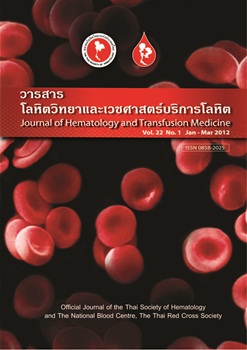Serratia Marcescens and Streptococcus Agalactiae (Group B Streptococcus) Contamination in Platelet Concentrates
Keywords:
Transfusion transmitted bacterial infection, Bacterial contamination in platelet concentrate, Serratia marcescens, Group B StreptococcusAbstract
Background : แบคทีเรียที่มักพบปนเปื้อนในเกล็ดเลือดมากที่สุดเป็นแบคทีเรียประจำถิ่นบริเวณผิวหนัง กลุ่ม coagulase-negative staphylococci เช่น S. epidermidis ศูนย์บริการโลหิตแห่งชาติ สภากาชาดไทย พบการปนเปื้อนเชื้อแบคทีเรียในเกล็ดเลือด 2 ราย ซึ่งไม่ใช่แบคทีเรียประจำถิ่นบนผิวหนังแต่เป็นแบคทีเรียที่เป็นสาเหตุของการติดเชื้อในโรงพยาบาล และ Group B Streptococci ซึ่งเป็นแบคทีเรียประจำถิ่นในลำไส้ ทางเดินป้สสาวะและทางเดินหายใจตอนบน Case report 1 : ในเดือนกรกฎาคม พ.ศ. 2553 โรงพยาบาลแห่งหนึ่งได้รายงานการเกิดปฏิกิริยาจากการรับเกล็ดเลือดชนิด platelet concentrates (PC) ซึ่งรับมาจากศูนย์บริการโลหิตแห่งชาติ โดยผู้ป่วยมีอาการไข้ หนาวสั่น ผลการเพาะเชื้อ PC พบ Serratia marcescens ศูนย์บริการโลหิตแห่งชาติได้นำ aged plasma จากผู้บริจาคคนเดียวกันไปทดสอบด้วยเครื่องตรวจแบคทีเรียปนเปื้อนอัตโนมัติ (BacT/ALERT 3D, Biomerieux, French) โดยเพาะเชื้อในอาหารเลี้ยงเชื้อชนิด BPA และ BPN สำหรับทดสอบแบคทีเรียใช้ออกซิเจนและไม่ใช้ออกซิเจนตามลำดับ พบว่าให้ผลบวกภายใน 24 ชั่วโมง ตรวจสอบพบเป็นแบคทีเรีย Serratia marcescens ตรงกับเชื้อแบคทีเรียที่โรงพยาบาลแจ้ง โดยเชื้อดังกล่าวเป็น facultative anaerobe ซึ่งเป็นสาเหตุสำคัญของการติดเชื้อในโรงพยาบาล Case report 2 : ในเดือนกันยายน พ.ศ. 2554 ฝ่ายควบคุมคุณภาพได้รับ PC ซึ่งถูกคัดออกจากฝ่ายผลิตส่วนประกอบโลหิตเนื่องจากมี aggregates ในถุง และนำมาเพาะเชื้อในวันที่ 9 นับจากวันเตรียม ให้ผลบวกภายใน 6 ชั่วโมง เมื่อย้อมแกรมและตรวจสอบพบเป็นแบคทีเรีย Streptococcus agalactiae (group B Streptococcus) ส่วนประกอบโลหิตชนิด packed red cells จากผู้บริจาคคนเดียวกันถูกจ่ายไปให้โรงพยาบาลและนำไปให้ผู้ป่วยหญิง ซึ่งทางโรงพยาบาลแจ้งว่าไม่พบปฏิกิริยาใดๆ ระหว่างการให้ส่วนประกอบโลหิต จากทั้ง 2 กรณีศูนย์บริการโลหิตแห่งชาติได้ดำเนินการทบทวนเอกสารการผลิตและการควบคุมคุณภาพถุงบรรจุโลหิตที่ใช้ในการเจาะเก็บโลหิต ไม่พบความผิดปกติใดๆ ผู้บริจาคโลหิตทั้ง 2 ราย เป็นผู้บริจาคโลหิตประจำทุก 3 เดือน มีสุขภาพแข็งแรง ไม่มีโรคประจำตัว ผลการเพาะเชื้อโลหิตผู้บริจาคไม่พบแบคทีเรียปนเปื้อน ผู้บริจาคโลหิตในกรณีที่ 2 ให้ข้อมูลว่าก่อนมาบริจาคโลหิตมีอาการเจ็บคอจึงรับประทาน ยาปฏิชีวนะเป็นเวลา 7 วัน ภายหลังบริจาคโลหิตมีอาการเจ็บคอมากขึ้น ภายหลังได้รับแจ้งจากศูนย์บริการโลหิตแห่งชาติจึงไปตรวจร่างกายที่โรงพยาบาลซึ่งไม่พบความผิดปกติใด Conclusion : การประเมินคัดกรองผู้บริจาคโลหิตอย่างมีประสิทธิภาพ ประกอบด้วย การใช้นํ้ายาฆ่าเชื้อและทำความสะอาดผิวหนังบริเวณที่จะเจาะ เก็บโลหิตด้วยเทคนิคที่ถูกต้อง การทิ้งโลหิตส่วนแรกประมาณ 30 mL ด้วย sample diversion pouch ร่วมกับการนำเทคนิควิธีสำหรับตรวจสอบการปนเปื้อนแบคทีเรียในส่วนประกอบโลหิตที่ให้ผลเร็ว จะทำให้สามารถกักกันผลิตภัณฑ์ที่ปนเปื้อนไม่ให้นำไปใช้ หรือสามารถเรียกคืนผลิตภัณฑ์ได้โดยเร็ว ช่วยลดความเสี่ยงจากการให้โลหิต ที่ติดเชื้อแบคทีเรียและเพิ่มความปลอดภัยให้แก่ผู้ป่วย
Key Words : Transfusion transmitted bacterial infection, Bacterial contamination in platelet concentrates, Serratia marcescens, Group B Streptococcus
Abstract
Background : The most common organism implicated with platelet bacterial contamination is normal skin flora, coagulase-negative staphylococci, such as ร. epidermidis. Recently, The Thai Red Cross Society, National Blood Centre (NBC) found 2 cases of bacterial contaminated platelet which were not caused by skin flora but bacteria causing nosocomial infection and Group B streptococci. Case report 1 In July 2010, a patient with gastro intestinal bleeding developed fever and shivering after receiving platelet transfusion. Platelet concentrates (PC) culture was positive and Serratia marcescens was found. A transfusion reaction was reported to NBC to investigate the causes of bacterial contamination. Aged plasma which was prepared from the same donation and stocked for plasma derivative production was cultured (BacT/ALERT, Biomerieux, French). Both anaerobic and aerobic culture bottles were positive within 24 hours and gram negative rod Serratia marcescens which was the nosocomial facultative anaerobic bacteria was identified. Case report 2 In September 2011, PC which was discarded from blood components production section due to aggregations was delivered to quality control section for bacterial culture. The platelet culture was performed on day 9 of manufacturing date. Aerobic and anaerobic cultures were positive within 6 hours. Gram stain and bacterial identification showed gram positive bacteria Streptococcus agalactiae (group B Streptococcus) which was commonly found in gastrointestinal tract, urinary tract and upper respiratory tract. The co-components, packed red ceUs was dispatched to another hospital and transfused to 60-year-old female. The patient showed no signs and symptoms of any transfusion reaction during and after transfusion and was discharged few days later. In these 2 cases, batch processing and quality control record of blood bags were reviewed and these records revealed no abnormalities of blood bag processing. Both donors were regular healthy males who donated blood every 3 months. They were requested for further evaluation and blood culture were negative. They felt พ๗/ at the time of donation but the donor from case report 2 said that he had sore throat and took antibiotics for 7 days before the day of blood donation. Conclusion : The effective blood donor evaluation, good skin disinfection method with effective disinfectants and removal of first aliquot blood with sample diversion pouch together with using high sensitivity bacterial detection system for rapid detection to quarantine or recall suspected blood components should be performed to reach the patient safety and decrease risk of bacterial contaminated blood transfusion.
Key Words : Transfusion transmitted bacterial infection, Bacterial contamination in platelet concentrate, Serratia marcescens, Group B Streptococcus



